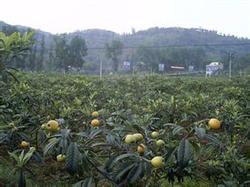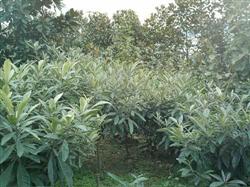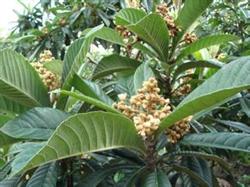Key points of loquat cultivation techniques in spring and summer in South China

The cultivation and management of loquat in spring and summer in southern China is very important, which has a great influence on the yield and quality of loquat. Only by conscientiously doing a good job in loquat cultivation and management, fertilizing, pest control, flower and fruit thinning and fruit bagging, can the loquat not only have high yield, good quality and low pesticide residue, but also meet the requirements of pollution-free green fruit as far as possible. to enhance its market competitiveness, can better economic benefits be obtained. First, apply strong fruit fertilizer. The fertilization of loquat should be dominated by organic fertilizer and supplemented by chemical fertilizer. 3 May is an important period for loquat growth and fruit growth, which requires a lot of water and nutrients to meet the needs of fruit growth. Therefore, a strong fruit fertilizer must be applied in the first and middle of March. Each loquat tree with fruit yield of more than 20 kg was treated with 50 kg of human and animal manure, 0.25 kg of potassium sulfate or 0.20 kg of potassium chloride, and 1 kg of calcium superphosphate or calcium phosphate fertilizer. Loquat trees with fruit less than 20 kg were treated with 25 kg of human and animal manure, 0.2 kg of potassium sulfate or 0.15 kg of potassium chloride. 0.5 kg of calcium superphosphate or calcium methionine fertilizer. In order to promote fruit growth, coloring and increase fruit sweetness, improve fruit quality. Second, do a good job in the prevention and control of diseases and pests. Spring and summer is the season with the most occurrence of loquat diseases and insect pests, such as loquat yellow caterpillar, aphids, heart-eating beetles, longicorn beetles, loquat brown rot, anthracnose and brown spot. In order to reduce diseases and insect pests and improve yield and quality, we should timely grasp the critical period of treating diseases and insect pests, select the right application of pesticides, and achieve the rotational use of drugs and the treatment of both diseases and insect pests. (1) in the first and middle of March, the ears were sprayed with 50 grams of omethoate, 50 grams of carbendazim and 50 kilograms of water. (2) before April 10, 50 grams of fenvalerate, 50 grams of topiramate, 100 grams of potassium dihydrogen phosphate, 50 kilograms of water, spray crowns and fruits. Third, fruit thinning and bagging to improve quality. The flowering and seed setting rate of loquat in Chongqing is high, with dozens of grains per panicle, but the fruit is small, poor in quality and sour in taste. The unit price of high-quality large fruit is 5 Murray 6 yuan per kilogram, while that of inferior small fruit is only 1 yuan / kg, and it is very difficult to sell. Loquat flower thinning and fruit thinning is an important measure to improve fruit quality and economic benefits. therefore, fruit farmers in loquat producing areas should actively promote loquat flower thinning and fruit thinning. Fruit thinning method: first disinfect the fruit thinning shears in boiling water, and then can be used for fruit thinning. In fruit thinning, the large fruit type varieties left 3 large fruits, 5 medium fruits, and no more than 8 small fruits per panicle. In fruit thinning, emphasis should be placed on the removal of diseases, pests and weak fruits, and the retention of strong and large fruits. After thinning the fruit, you should immediately kill 50 grams with the enemy, add 100 grams of carbendazim with 50 kilograms of water, and spray the crown, branches, leaves and fruits evenly to prevent and control diseases and insect pests. In order to improve the quality of loquat, bagging should be carried out in addition to other measures, because bagging can not only reduce the amount of pesticides, make the results meet the requirements of pollution-free green food, but also make the fruit surface smooth, so as to improve the quality and increase the competitiveness of the market. The bagging time was carried out in the early stage of loquat fruit from green to yellow. Before bagging, you must use the enemy to kill 50 grams, add 50 grams of carbendazim, 50 kilograms of water, spray the crown and fruit, and bag the next day after the solution dries. Fourth, the management of high grafting and replacement of loquat trees in autumn. (1) shearing anvil dew bud: in the first and middle of March, the loquat tree which was highly grafted last autumn was cut and sawed 0.5 cm above the buds, and the budding bud was exposed after the sawing rootstock. (2) removing the film and removing the sprouting: remove the sprouting every 10 days or so after cutting the anvil or sawing the anvil, and unbind the film after the Lignification of the spring shoots in 6muri-July. (3) fertilization for shoot promotion: shoot promotion fertilizer was applied once in March and July, and 15 kilograms of human and animal manure were applied to each plant according to the size of the tree. Potassium sulfate 0.25 kg, superphosphate 1 kg, ditch fertilization, fertilizer dry cover soil fertilizer. (4) coring: when the tip of the grafted branch grows to 15 cm long, it is necessary to pick the heart in time to promote the robust growth of the shoot and multiple shoots. (5) Prevention and control of diseases and insect pests: timely control of loquat aphids, yellow caterpillars and anthracnose during the emergence of loquat branches and shoots, and use pesticides and formulations to control loquat diseases and pests.
- Prev

Scientific Management of Postharvest Loquat
At present, the basic harvest of loquat is over, and the postharvest production management is directly related to the tree potential growth and next year's fruit. The postharvest production management of loquat should be carried out mainly from three aspects: fertilization, pruning and pest control. Full postharvest fertilizer loquat should be fertilized in time to promote the development of summer shoots, mainly nitrogen fertilizer.
- Next

Do a good job in postharvest management of loquat to ensure a good harvest in the coming year
Loquat is basically picked in May, and postharvest production management is directly related to tree potential growth and next year's fruit. The postharvest production management of loquat should be carried out mainly from three aspects: fertilization, pruning and pest control. Full postharvest fertilizer loquat should be fertilized in time to promote the development of summer shoots, mainly nitrogen fertilizer.
Related
- Moge, come on! The staff of the peasant association in the producing area of cantaloupe were frightened when the crowd gathered.
- Causes and Solutions of low Fruit setting rate of Apple
- Symptoms and control measures of passion fruit virus disease
- Fruit growing lesson: how do apple orchards keep high yields?
- Can you build orchards in the mountains? What are the pros and cons?
- How to manage the coloring period of Crisson grape?
- This paper introduces the processing technology of two kinds of fig products.
- How much is a month for retired teachers in rural areas by 2020?
- How can strawberry planting increase sugar content? We should pay attention to management in many aspects.
- What are the cultivation techniques on how to improve the yield of golden fruit?

